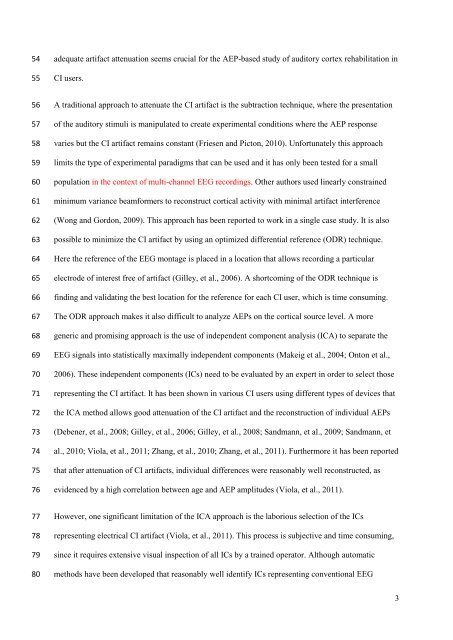Elsevier Editorial System(tm) for Hearing Research Manuscript Draft ...
Elsevier Editorial System(tm) for Hearing Research Manuscript Draft ...
Elsevier Editorial System(tm) for Hearing Research Manuscript Draft ...
Create successful ePaper yourself
Turn your PDF publications into a flip-book with our unique Google optimized e-Paper software.
54<br />
55<br />
56<br />
57<br />
58<br />
59<br />
60<br />
61<br />
62<br />
63<br />
64<br />
65<br />
66<br />
67<br />
68<br />
69<br />
70<br />
71<br />
72<br />
73<br />
74<br />
75<br />
76<br />
77<br />
78<br />
79<br />
80<br />
adequate artifact attenuation seems crucial <strong>for</strong> the AEP-based study of auditory cortex rehabilitation in<br />
CI users.<br />
A traditional approach to attenuate the CI artifact is the subtraction technique, where the presentation<br />
of the auditory stimuli is manipulated to create experimental conditions where the AEP response<br />
varies but the CI artifact remains constant (Friesen and Picton, 2010). Un<strong>for</strong>tunately this approach<br />
limits the type of experimental paradigms that can be used and it has only been tested <strong>for</strong> a small<br />
population in the context of multi-channel EEG recordings. Other authors used linearly constrained<br />
minimum variance beam<strong>for</strong>mers to reconstruct cortical activity with minimal artifact interference<br />
(Wong and Gordon, 2009). This approach has been reported to work in a single case study. It is also<br />
possible to minimize the CI artifact by using an optimized differential reference (ODR) technique.<br />
Here the reference of the EEG montage is placed in a location that allows recording a particular<br />
electrode of interest free of artifact (Gilley, et al., 2006). A shortcoming of the ODR technique is<br />
finding and validating the best location <strong>for</strong> the reference <strong>for</strong> each CI user, which is time consuming.<br />
The ODR approach makes it also difficult to analyze AEPs on the cortical source level. A more<br />
generic and promising approach is the use of independent component analysis (ICA) to separate the<br />
EEG signals into statistically maximally independent components (Makeig et al., 2004; Onton et al.,<br />
2006). These independent components (ICs) need to be evaluated by an expert in order to select those<br />
representing the CI artifact. It has been shown in various CI users using different types of devices that<br />
the ICA method allows good attenuation of the CI artifact and the reconstruction of individual AEPs<br />
(Debener, et al., 2008; Gilley, et al., 2006; Gilley, et al., 2008; Sandmann, et al., 2009; Sandmann, et<br />
al., 2010; Viola, et al., 2011; Zhang, et al., 2010; Zhang, et al., 2011). Furthermore it has been reported<br />
that after attenuation of CI artifacts, individual differences were reasonably well reconstructed, as<br />
evidenced by a high correlation between age and AEP amplitudes (Viola, et al., 2011).<br />
However, one significant limitation of the ICA approach is the laborious selection of the ICs<br />
representing electrical CI artifact (Viola, et al., 2011). This process is subjective and time consuming,<br />
since it requires extensive visual inspection of all ICs by a trained operator. Although automatic<br />
methods have been developed that reasonably well identify ICs representing conventional EEG<br />
3
















